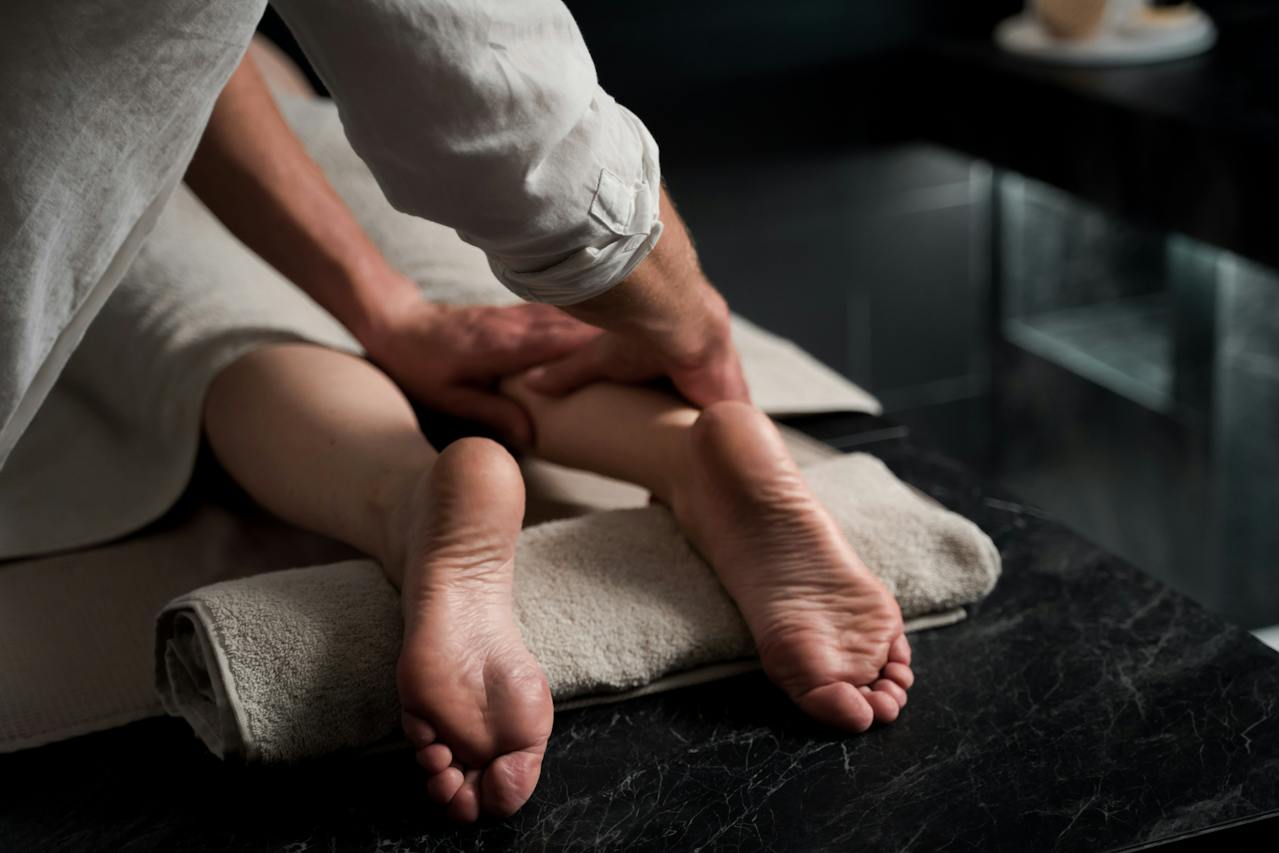Therapeutic massage is a widely used treatment for sports injuries. Athletes often turn to this form of therapy to aid in their recovery and enhance performance. But what exactly makes therapeutic massage effective?
Research conducted by experts in the field has shown that therapeutic massage can have profound effects on the human body. By manipulating soft tissues, such as muscles and tendons, therapists are able to promote relaxation, improve blood flow, reduce inflammation, and alleviate pain. These physiological responses contribute to faster healing and enhanced range of motion for athletes recovering from sports-related injuries.
By understanding the science behind therapeutic massage, athletes can make informed decisions about incorporating it into their training regimen. Join us as we explore the research and evidence supporting the effectiveness of therapeutic massage in sports medicine.
Exploring The Healing Touch Of Massage Therapy
The Science Behind Massage’s Effectiveness
Massage therapy has long been recognized for its ability to promote healing and provide relief from various ailments. One of the reasons why massage works so effectively is due to its impact on our body’s chemistry. When we receive a massage, our bodies release endorphins, which are natural pain-relieving chemicals. This helps to alleviate discomfort and reduce pain associated with sports injuries.
Massage therapy helps to lower cortisol levels in the body. Cortisol is a hormone that is released during times of stress, and elevated levels can hinder the healing process. By reducing cortisol levels through therapeutic massage, individuals experience reduced stress and increased relaxation, allowing their bodies to focus on healing.
Another way massage therapy aids in healing is by increasing blood flow and lymphatic drainage. During a massage, pressure applied to the muscles stimulates blood circulation, delivering oxygen and nutrients to injured tissues. This improved blood flow accelerates the healing process by supplying essential resources needed for tissue repair.
Neurophysiological Mechanisms At Work
Massage therapy also affects our nervous system in several ways that contribute to its effectiveness. When receiving a massage, sensory receptors in our skin are activated through techniques such as kneading or long strokes. This activation leads to a decrease in pain perception as these receptors send signals that override pain signals being sent to the brain.
Furthermore, therapeutic massage has been shown to modulate the autonomic nervous system. This modulation promotes relaxation and reduces anxiety by activating the parasympathetic response known as the “rest-and-digest” state. As a result, individuals experience a sense of calmness and tranquility during their treatment sessions.
In addition to these effects on pain perception and relaxation, massage therapy also influences neurotransmitters within our brains. Serotonin and dopamine are two neurotransmitters released during massages that enhance mood and promote feelings of well-being. These chemical changes contribute to the overall positive experience and therapeutic benefits of massage therapy.
Massage In Sports Medicine Context
Massage therapy plays a crucial role in sports medicine practices. It is often used as a complementary treatment alongside other interventions such as physical therapy and rehabilitation exercises. Athletes, both professional and recreational, benefit from incorporating massage into their training regimens.
Therapeutic massage helps prevent sports-related injuries by improving flexibility, reducing muscle tension, and increasing range of motion. Regular sessions can also aid in the recovery process by promoting faster healing of damaged tissues, reducing inflammation, and alleviating pain associated with sports injuries.
Furthermore, massage therapy assists athletes in managing stress levels that arise from intense training or competition. By providing relaxation and promoting mental well-being, it contributes to an athlete’s overall performance and helps prevent burnout.
The Role Of Massage In Injury Prevention
Massage therapy plays a crucial role in preventing sports injuries and enhancing athletic performance. Let’s explore how massage helps athletes strengthen their motor abilities and prepare for events.
Strengthening Motor Abilities
Massage has been shown to have a positive impact on muscle strength, flexibility, coordination, and balance. Through targeted techniques, massage therapists can manipulate the muscles, promoting increased blood flow and oxygen delivery. This results in improved muscle function and enhanced athletic performance.
One of the key benefits of massage is its ability to increase proprioception, which refers to our body’s awareness of its position in space. By improving proprioception, athletes can better control their movements and maintain proper form during physical activities. This leads to improved coordination and balance, reducing the risk of falls or missteps that could result in injury.
Regular massage sessions help improve muscle flexibility by reducing tension and increasing range of motion. Tight muscles can restrict movement and make athletes more susceptible to strains or sprains. Massage helps alleviate muscle tightness by releasing knots or trigger points, allowing for smoother movements during training or competition.
Pre-Event Preparation Techniques
Massage therapy is commonly used as part of pre-event preparation for athletes. Before an event, receiving a massage can help warm up muscles and increase blood flow to the tissues. This prepares the body for intense physical activity by loosening up tight muscles and promoting flexibility.
Beyond its physical benefits, pre-event massages also have psychological advantages for athletes. By reducing anxiety levels and promoting relaxation, massage therapy helps athletes enter a focused mindset before competing. It allows them to clear their minds from distractions and mentally prepare themselves for optimal performance.
Specific techniques like effleurage (long sweeping strokes) or petrissage (kneading motions) are often utilized during pre-event massages to stimulate circulation further. These techniques help enhance blood flow to the muscles while providing a soothing effect on the nervous system.
Therapeutic Massage For Injury Rehabilitation
Massage therapy plays a crucial role in the rehabilitation of sports injuries. By understanding the science behind it, we can better appreciate why therapeutic massage is effective in aiding recovery and promoting healing.
Enhancing Muscle Regeneration
Massage has been found to enhance muscle regeneration by addressing key factors that contribute to tissue repair. One way it achieves this is by reducing inflammation and swelling. Through targeted manipulation of soft tissues, massage helps to alleviate the buildup of fluid and reduce swelling, allowing injured muscles to heal more effectively.
Massage aids in the removal of metabolic waste products from tissues. When an injury occurs, waste products accumulate in the affected area, hindering the healing process. Massage helps to stimulate lymphatic circulation, facilitating the removal of these waste products and promoting a healthier environment for tissue repair.
Improved circulation is another benefit of therapeutic massage. The kneading and stroking motions applied during a massage session help increase blood flow to injured areas. This enhanced circulation delivers oxygen and essential nutrients necessary for tissue repair, supporting the regeneration process.
Evicting Neutrophils For Better Healing
Neutrophils are white blood cells that play a crucial role in initiating the inflammatory response following an injury. However, their prolonged presence can delay the healing process. Therapeutic massage can help expedite this transition from the inflammatory phase to the proliferative phase by assisting in removing neutrophils from injured tissues.
By applying specific techniques such as effleurage and petrissage during a massage session, therapists can promote lymphatic drainage and facilitate the elimination of neutrophils from damaged areas. This accelerates healing and allows for a quicker return to training or competition.
The Benefits Of Massage For Injured Muscles
Massage therapy has been widely recognized as an effective treatment for sports injuries. It offers a range of benefits that aid in the healing and recovery process of injured muscles. Let’s delve into some key advantages of therapeutic massage for athletes with muscle damage.
Pain Relief And Reduced Inflammation
One significant benefit of massage therapy is its ability to provide pain relief and reduce inflammation in injured muscles. Through the gate control theory, massage helps decrease pain perception by stimulating sensory receptors, which send signals to the brain, overriding pain sensations.
Furthermore, massage increases the production of anti-inflammatory cytokines, which are substances that help regulate inflammation in the body. By promoting the release of these cytokines, massage therapy effectively reduces inflammation in injured muscles, alleviating discomfort and swelling.
Athletes who undergo regular therapeutic massages often experience relief from both acute and chronic pain caused by sports-related injuries. The targeted manipulation of soft tissues helps soothe soreness, reduce muscle tension, and enhance overall comfort during the healing process.
Improved Circulation And Flexibility
Massage therapy also plays a crucial role in improving circulation and flexibility in injured muscles. By applying pressure to specific areas, massage stimulates blood flow to the affected muscles. This increased circulation delivers essential oxygen and nutrients necessary for tissue repair and regeneration.
Moreover, therapeutic massage techniques involve stretching and elongating muscle fibers gently. This stretching action helps improve flexibility by increasing joint range of motion and enhancing muscle elasticity. As a result, athletes can regain their mobility more quickly after sustaining an injury.
Improved circulation aids in the removal of metabolic waste products accumulated within untreated muscles. These waste products can hinder proper healing by impeding nutrient delivery to the damaged tissues. Massage therapy facilitates efficient waste elimination from injured muscles, supporting faster recovery times.
Sports Massage For Recovery Enhancement
Massage therapy has been widely recognized as a valuable tool in sports injury recovery and prevention. Athletes often turn to therapeutic massage to aid in their post-event recovery strategies and receive ongoing support for their physical well-being. Let’s explore how sports massage works and why it is beneficial for athletes.
Post-Event Recovery Strategies
After participating in intense physical activity, such as a sports event or competition, athletes may experience delayed onset muscle soreness (DOMS). However, studies have shown that receiving a massage after an event can help prevent or alleviate this discomfort.
Massage promotes relaxation by reducing muscle tension and increasing blood flow to the muscles. This increased circulation aids in the removal of waste products, such as lactic acid, which can contribute to muscle soreness. By addressing these issues promptly, athletes can enhance their recovery process.
Therapists utilize specific techniques like deep tissue massage and trigger point therapy during post-event recovery sessions. Deep tissue massage targets the deeper layers of muscles and connective tissues to release tension and improve flexibility. Trigger point therapy focuses on relieving localized areas of tightness or knots within the muscles.
Ongoing Support For Athletes
Regular sports massage sessions provide ongoing support for athletes’ physical well-being beyond immediate post-event recovery. By scheduling regular massages, athletes can identify potential issues before they develop into more severe injuries.
Athletes who receive regular massages benefit from improved performance due to enhanced flexibility, range of motion, and reduced muscle tension. The therapist can also address any imbalances or weaknesses that may increase the risk of injury during training or competition.
Regular massages contribute to faster recovery times between training sessions or events. The increased blood flow stimulated by massage helps deliver essential nutrients and oxygen to the muscles, promoting healing and reducing downtime.
Collaborative Approaches In Sports Massage Therapy
Integrating Different Techniques
Various massage techniques can be combined to address specific athlete needs.A collaborative approach in massage therapy proves to be highly effective. By integrating different techniques, such as sports massage, deep tissue massage, and myofascial release, therapists can provide comprehensive treatment for athletes.
Combining these techniques allows therapists to target different layers of muscle tissue and address various aspects of the injury. Sports massage focuses on improving circulation and flexibility while reducing muscle tension and soreness. Deep tissue massage targets deeper layers of muscles and connective tissues to release chronic tension and break up scar tissue. Myofascial release aims to stretch and loosen the fascia, the connective tissue that surrounds muscles.
By integrating these techniques into a single session or treatment plan, therapists can tailor their approach based on an athlete’s specific injury or condition. For example, if an athlete has a strained hamstring muscle, the therapist may start with sports massage techniques to warm up the area and improve blood flow. Then they may transition into deep tissue massage to release any knots or adhesions within the muscle fibers. Finally, myofascial release techniques could be used to stretch and lengthen the fascia surrounding the injured area.
Personalized Treatment Plans
In sports massage therapy, personalized treatment plans are crucial for optimal results. Athletes have unique needs and goals. A one-size-fits-all approach simply won’t suffice.
Therapists begin by conducting thorough assessments of athletes’ specific injuries or conditions. This assessment guides them in choosing appropriate massage techniques tailored to each individual’s needs. For instance, if an athlete is dealing with a sprained ankle, the therapist will focus on lymphatic drainage techniques to reduce swelling along with gentle joint mobilization exercises.
Personalization ensures that every aspect of the treatment plan is designed to maximize the effectiveness of massage therapy. By targeting specific areas of concern and utilizing techniques that are most beneficial for each athlete, therapists can help accelerate healing, reduce pain, and improve overall performance.
Broadening The Utilization Of Massage Therapy
Beyond Traditional Sports Settings
Therapeutic massage is not limited to athletes in traditional sports settings. It offers benefits that extend to individuals engaging in non-traditional sports and recreational activities. Whether you enjoy hiking, cycling, swimming, or any other physical activity, therapeutic massage can prove to be a valuable tool for injury prevention and treatment.
Massage therapy plays a crucial role in addressing the unique demands of these activities. By targeting specific muscle groups and areas prone to strain or overuse, massage helps alleviate tension and promote relaxation. This, in turn, reduces the risk of injuries commonly associated with these activities.
Potential In Amateur And Recreational Sports
While professional athletes often seek out therapeutic massage as part of their training regimen, amateur and recreational athletes can also benefit greatly from this practice. Massage therapy is accessible to athletes at all levels of participation, allowing them to reap its rewards.
One key advantage for amateur and recreational athletes is injury prevention. Regular massages help identify and address muscular imbalances or tightness that may lead to injuries down the line. By promoting better alignment and flexibility, massage therapy enhances overall performance while reducing the risk of strains or sprains.
In addition to injury prevention, therapeutic massage contributes to an athlete’s overall well-being. The physical demands placed on the body during sports activities can result in muscle soreness, fatigue, and stress. Massage helps alleviate these symptoms by increasing blood flow, relaxing muscles, and releasing endorphins – natural painkillers that promote a sense of well-being.
Moreover, therapeutic massage has been shown to improve sleep quality among athletes. Quality sleep is vital for recovery and optimal performance as it allows the body time to repair itself from the physical stresses endured during exercise.
Massage therapy also provides psychological benefits for amateur and recreational athletes. It offers a valuable opportunity for relaxation and stress reduction after intense workouts or competitions. The calming effect of massage can help athletes manage anxiety, improve focus, and enhance their overall mental well-being.
Conclusion
In conclusion, therapeutic massage has proven to be an effective treatment for sports injuries. Through its healing touch, massage therapy plays a crucial role in injury prevention, rehabilitation, and recovery enhancement. The benefits of massage for injured muscles are numerous, including improved circulation, reduced pain and inflammation, and increased flexibility. Furthermore, collaborative approaches in sports massage therapy have shown promising results in optimizing athletes’ performance and overall well-being.
To fully harness the potential of therapeutic massage in sports injury management, it is essential for athletes, coaches, and healthcare professionals to recognize its value and incorporate it into their training programs. By integrating regular massage sessions into their routines, athletes can proactively prevent injuries and enhance their recovery process. Coaches and healthcare professionals should also collaborate with skilled massage therapists to develop personalized treatment plans that address specific needs and goals.
By embracing the science behind therapeutic massage and leveraging its benefits, athletes can unlock their full potential while minimizing the risk of injuries. It is through this holistic approach that sports performance can be optimized, allowing athletes to excel in their respective fields.
Sources:
Harnessing The Power Of Therapeutic Massage For Sports Injuries: Your Path To Recovery!
Are you struggling with the aftermath of a sports injury, feeling hampered by pain and limited mobility? Turn to the experts at MedicinEvolution, where the healing touch of Therapeutic Massage is expertly applied to target your sports-related injuries, offering a path to effective recovery! Wave goodbye to the discomfort caused by strained muscles, overexertion, and repetitive sports movements—as MedicinEvolution taps into the root causes of your injury, facilitating a transformative healing process. With their skilled approach, you’ll experience a remarkable turnaround from the pain that once hindered your athletic performance!
Whether you’re grappling with persistent pain, stiffness, or the frustrating limitations of a sports injury, their specialized methods are designed to meet the specific needs of your condition. Don’t let injury setbacks control your athletic journey—take the reins and schedule your session with MedicinEvolution today! Step into the realm of Therapeutic Massage and embark on a road to a more active, pain-free life. Your body—and your athletic aspirations—will be grateful!





